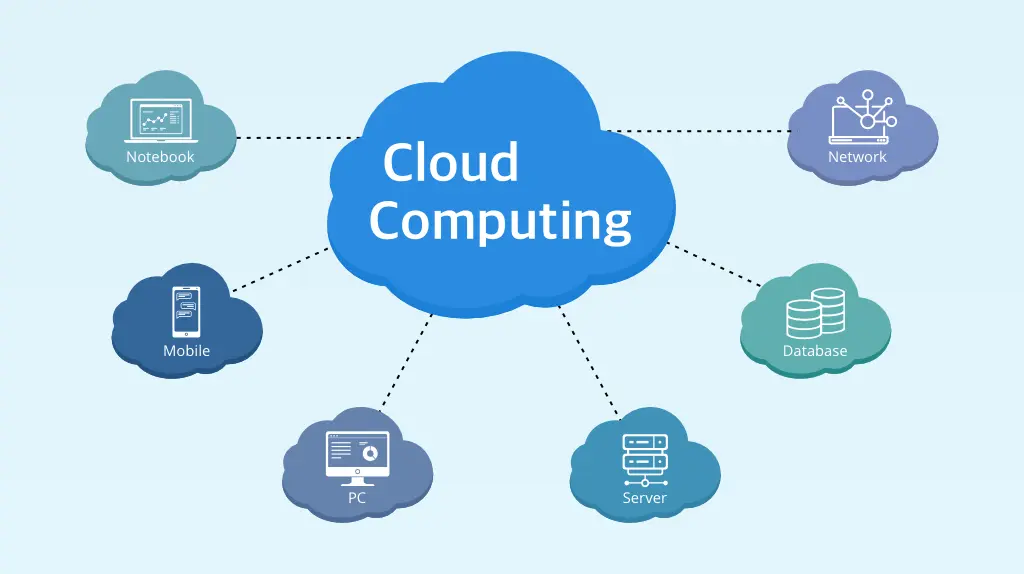Table of contents
Cloud or cloud computing is the availability of computer resources and systems on-demand, without the user having to manage those systems and the infrastructure required. Cloud computing relies on data centers that are located around the world, and larger clouds can utilize dozens or hundreds of these distributed data centers.

The internet has radically changed almost every aspect of our daily lives, but with the advent of cloud computing, it’s set to change things even more. Why? Cloud computing means that you can leverage the massive data centers and servers for even personal computing needs, through an internet connection. That allows for high-performance applications and massive amounts of data to be stored and processed away from your actual devices.
Why is it called the cloud?
It’s no accident that the term the “cloud” is the same as the white fluffy things in the sky. The term essentially comes from the fact that a symbol of an actual cloud is commonly used in computer network diagrams when referring to the internet. The use of these symbols dates back to Compaq in 1996, and was later popularized in 2006, when Amazon launched the Elastic Compute Cloud, or EC2.
Today, the cloud essentially refers to servers that are accessed over the internet, and to the software and infrastructure that runs on those servers.
The servers that make up the cloud are located…all over the place. All of the major tech companies run their own cloud servers. Apple runs them for iCloud, Apple TV, Apple Music, and more. Google runs them for Google Drive, running Google Search, and so on. But perhaps the biggest cloud operator is Amazon, which runs Amazon Web Services that essentially serves as the backbone to much of the internet.
Without the cloud, most of how we use the internet today wouldn’t work.
How does cloud computing work?
Cloud computing involves delivering various services through the internet, including data storage, servers, databases, networking, and software, among others. Instead of storing files on a hard drive, SSD, or storage device, cloud-based storage files can be saved to a remote database. This means that as long as there’s an internet connection, the data, like photos, documents, or videos, can be accessed from any location and on any device.
The process begins when you send data over the internet to a data center, which is a large collection of servers in a physical location. These data centers are owned and maintained by cloud service providers like Amazon Web Services, Microsoft Azure, or Google Cloud. Your data and applications are then stored on these servers. When you need to access your data, your device communicates with the server, which sends the data back to your device over the internet.
Cloud computing is also highly flexible and scalable. This means that it can handle fluctuations in your needs. For instance, if your workload increases, more server capacity can be allocated to handle it, and when the workload decreases, the extra server capacity can be reduced. This flexibility is a significant advantage over traditional computing, which requires a significant amount of time and resources to increase capacity. Moreover, with cloud computing, you usually only pay for what you use, which makes it a cost-effective solution for many individuals and businesses.
Different types of cloud computing
Cloud computing comes in different types, each designed to serve different needs. The four primary types of cloud computing are known as Infrastructure as a Service (IaaS), Platform as a Service (PaaS), Software as a Service (SaaS), and Function as a Service (FaaS). Here’s a look at each.
Infrastructure as a Service (IaaS)
Infrastructure as a Service (IaaS) is known as the most flexible type of cloud computing. IaaS allows businesses to rent IT infrastructures, such as servers, virtual machines (VMs), storage, networks, and operating systems. These are rented from a cloud provider on a pay-as-you-go basis. This eliminates the capital expense of investing in physical hardware and reduces the need for IT staff to manage it. Examples of IaaS providers include the likes of Amazon Web Services (AWS) and Google Cloud Platform (GCP).
Platform as a Service (PaaS)
Next up is Platform as a Service (PaaS), which is a cloud computing model in which a service provider can offer a platform for customers to develop, run, and manage applications without having to deal with the complexity of building and maintaining the infrastructure that’s often associated with developing and launching an app. This includes tools for design, development, testing, and hosting of apps. Examples of PaaS providers are Microsoft Azure and Heroku.
Software as a Service (IaaS)
Software as a Service (SaaS) is where applications are hosted by a cloud service provider, and are made available to customers over the Internet. Users don’t need to worry about installation, maintenance, or coding, as everything is managed by the service provider. Examples of SaaS applications are Google Workspace (formerly G Suite), Salesforce, and Dropbox.
Function as a Service (FaaS)
Function as a Service is a cloud computing category that essentially allows developers to execute a functionality of an application, without having to worry about the infrastructure underpinning that application. Commonly, FaaS is used in serverless computing, and allows developers to write and update code quickly, then executing the code in response to an event. An example of FaaS is AWS Lambda, which allows developers to upload their code, after which it’s scaled and run automatically as needed.
Types of cloud deployments
Like types of cloud computing, there are four main types of cloud deployments, or ways for cloud services to be implemented. Here’s a look at them.
Private Cloud
Private cloud deployments are essentially controlled by a single organization and used only by that business. They are sometimes located at the physical site of the organization, or sometimes hosted by a third-party provider, however regardless, the services in that cloud are maintained by a single party. Private cloud deployments are known for their flexibility and scalability.
Public Cloud
Public cloud deployments are the most common type of deployment. In a public cloud deployment, resources are owned by a third-party provider and accessed over the internet. All of the hardware and infrastructure are owned and managed by a cloud provider, like Amazon Web Services. They’re known for being cheaper, and requiring little to no maintenance, however they’re much more reliable.
Hybrid Cloud
A hybrid cloud deployment offers the best of both worlds. In a hybrid cloud environment, a mix of private and public cloud services are used, with services connecting the two. An organization, for example, might use a private cloud for sensitive operations, and a public cloud for other operations.
Multi-Cloud
In a multi-cloud setup, a business uses multiple cloud services from different cloud service providers. In this case, there could be a combination of public, private, and hybrid cloud setups, and they don’t necessarily communicate or work together. A business might employ a multi-cloud setup to mitigate risks and avoid being locked in by a single provider.
Applications enabled by cloud computing
Cloud computing enables a wide range of applications, many of which we’re already using today and others that are still emerging.
One common application is data storage and backup. Services like Google Drive, Dropbox, and iCloud allow users to store, backup, and sync their files across different devices and share them with others. These applications ensure data is safe from local hardware failures and allows easy access from anywhere with an internet connection.
Another significant application of cloud computing is in software delivery through Software as a Service (SaaS) model. Many of the software programs we use daily, like Microsoft Office 365, Salesforce, and Adobe Creative Cloud, are delivered as SaaS. They’re accessible over the internet, and users don’t have to worry about installation or maintenance.
Over time, cloud computing will continue to enable more applications as tech continues to evolve. For example, with the rise of virtual reality (VR) and augmented reality (AR), the cloud could provide the necessary processing power to render complex, immersive environments in real-time. Cloud gaming is another burgeoning application of cloud computing. Traditional gaming requires a powerful local device, like a gaming console or a high-end PC, to render the complex graphics and gameplay of modern games. However, cloud gaming shifts the heavy lifting to cloud servers, meaning users can play high-end titles on all of their devices, no matter the graphics performance.
Benefits of cloud computing
Cloud computing offers numerous benefits that make it an appealing option for individuals and businesses alike. One of the most notable of those benefits is cost efficiency. With cloud computing, you don’t need to invest heavily in buying and maintaining hardware or data centers. Instead, you pay for what you use, much like a utility bill. This model also removes the cost of upgrading systems, as service providers handle all updates and upgrades.
Scalability and flexibility are another significant advantages of cloud computing. Depending on your needs, you can easily scale up or down your cloud capacity, making it more flexible than traditional servers. If your business has peak periods, you can scale up your cloud resources and then scale back down when you don’t need as much. This flexibility can also support business growth, as you can gradually increase your IT resources without a large upfront investment.
Cloud computing also promotes work efficiency and collaboration. Since data is stored in the cloud and accessible over the internet, team members can access the same files and applications from anywhere, using any device. This makes it easier for global teams to collaborate and for employees to work remotely.
Finally, cloud computing also offers the benefit of disaster recovery. With data stored in the cloud, it’s easier to recover information in case of a data loss event, as most cloud providers offer data backup and data recovery services as part of their offering. This means businesses don’t need to set up complex disaster recovery plans themselves, saving time and avoiding significant upfront investment.

